flat tire BMW 328I XDRIVE CONVERTIBLE 2011 E94 User Guide
[x] Cancel search | Manufacturer: BMW, Model Year: 2011, Model line: 328I XDRIVE CONVERTIBLE, Model: BMW 328I XDRIVE CONVERTIBLE 2011 E94Pages: 278, PDF Size: 8.23 MB
Page 214 of 278
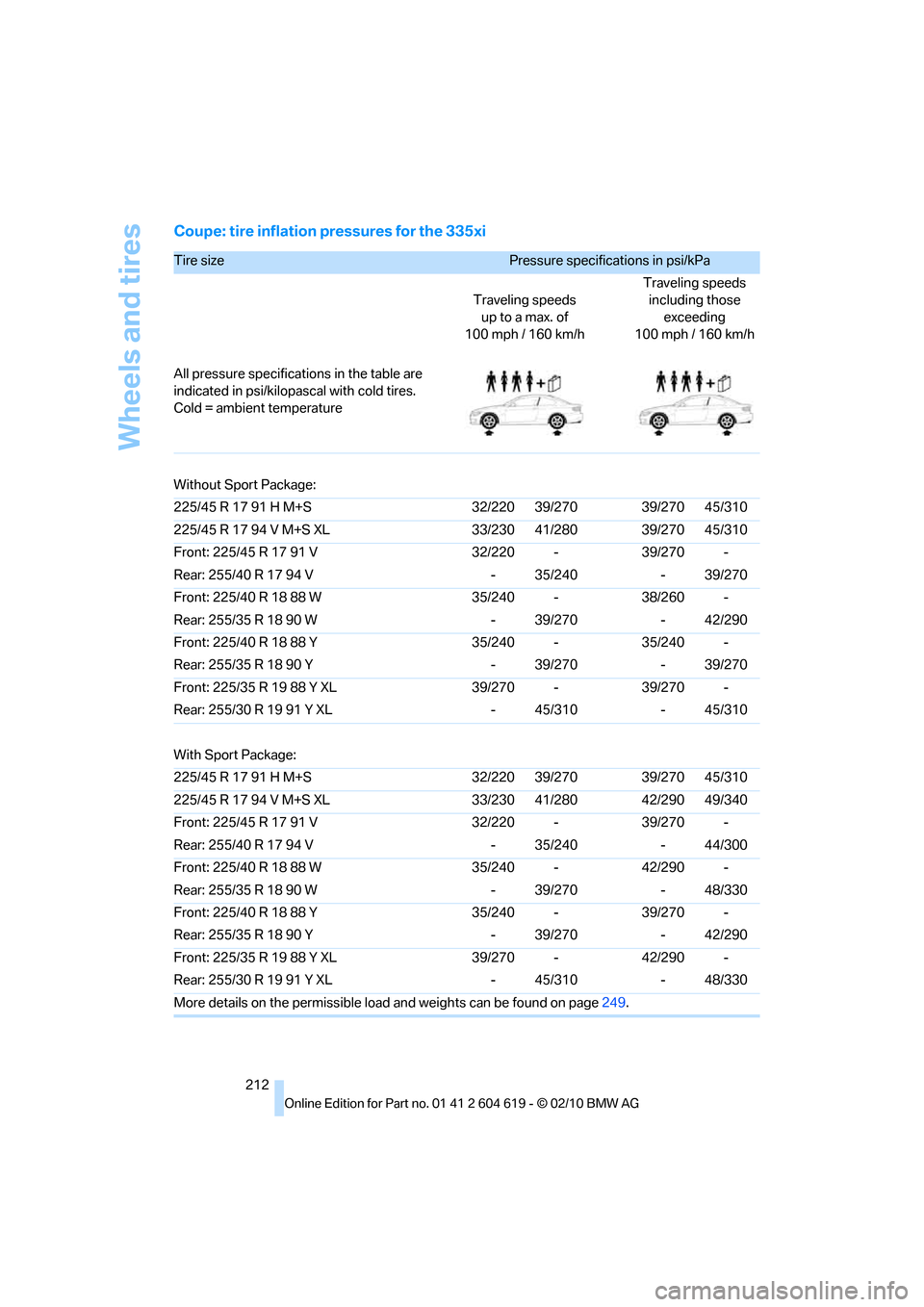
Wheels and tires
212
Coupe: tire inflation pressures for the 335xi
Tire size Pressure specifications in psi/kPa
Traveling speeds
up to a max. of
100 mph / 160 km/hTraveling speeds
including those
exceeding
100 mph / 160 km/h
All pressure specifications in the table are
indicated in psi/kilopascal with cold tires.
Cold = ambient temperature
Without Sport Package:
225/45 R 17 91 H M+S 32/220 39/270 39/270 45/310
225/45 R 17 94 V M+S XL 33/230 41/280 39/270 45/310
Front: 225/45 R 17 91 V 32/220 - 39/270 -
Rear: 255/40 R 17 94 V - 35/240 - 39/270
Front: 225/40 R 18 88 W 35/240 - 38/260 -
Rear: 255/35 R 18 90 W - 39/270 - 42/290
Front: 225/40 R 18 88 Y 35/240 - 35/240 -
Rear: 255/35 R 18 90 Y - 39/270 - 39/270
Front: 225/35 R 19 88 Y XL 39/270 - 39/270 -
Rear: 255/30 R 19 91 Y XL - 45/310 - 45/310
With Sport Package:
225/45 R 17 91 H M+S 32/220 39/270 39/270 45/310
225/45 R 17 94 V M+S XL 33/230 41/280 42/290 49/340
Front: 225/45 R 17 91 V 32/220 - 39/270 -
Rear: 255/40 R 17 94 V - 35/240 - 44/300
Front: 225/40 R 18 88 W 35/240 - 42/290 -
Rear: 255/35 R 18 90 W - 39/270 - 48/330
Front: 225/40 R 18 88 Y 35/240 - 39/270 -
Rear: 255/35 R 18 90 Y - 39/270 - 42/290
Front: 225/35 R 19 88 Y XL 39/270 - 42/290 -
Rear: 255/30 R 19 91 Y XL - 45/310 - 48/330
More details on the permissible load and weights can be found on page249.
Page 215 of 278
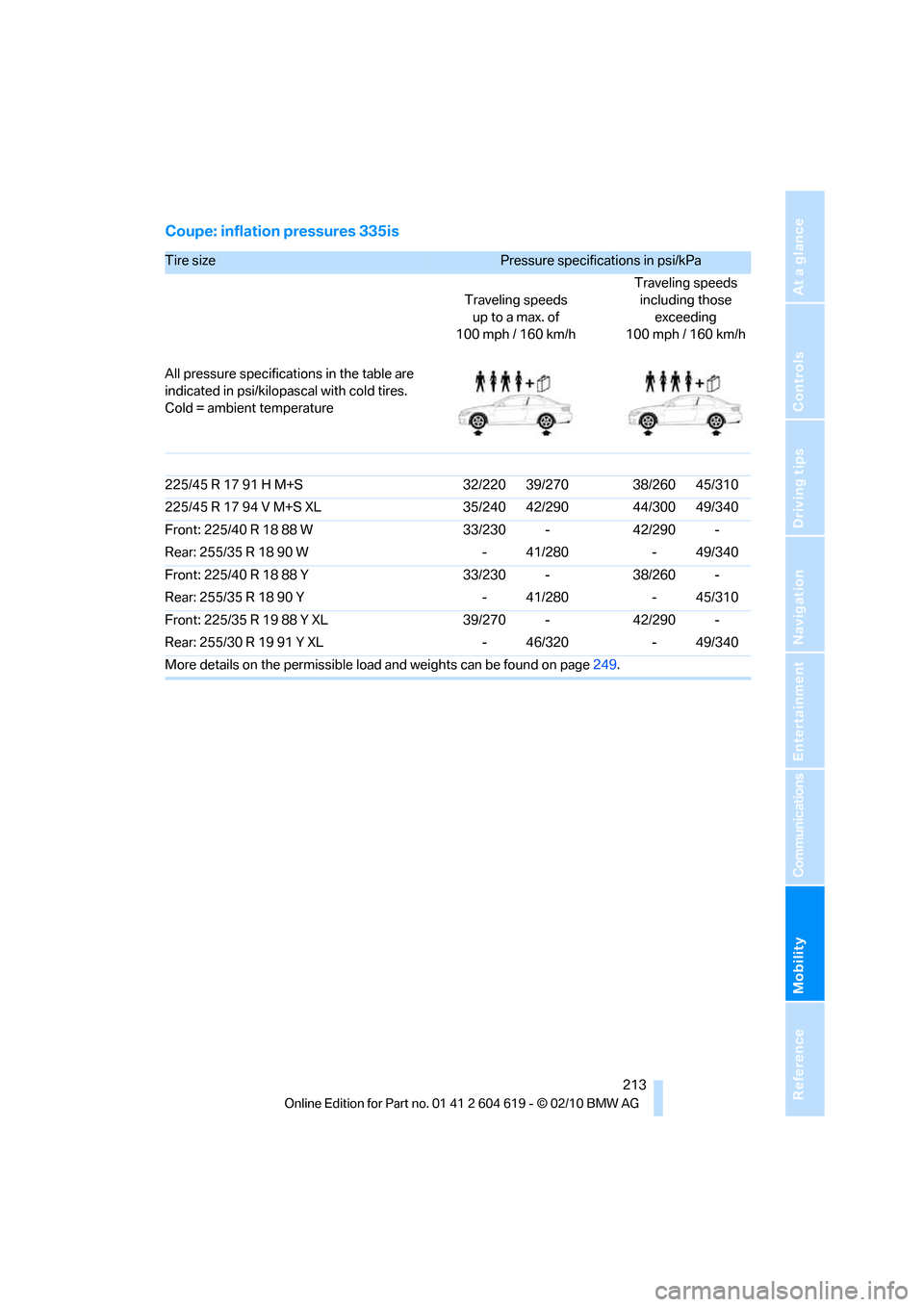
Mobility
213Reference
At a glance
Controls
Driving tips
Communications
Navigation
Entertainment
Coupe: inflation pressures 335is
Tire size Pressure specifications in psi/kPa
Traveling speeds
up to a max. of
100 mph / 160 km/hTraveling speeds
including those
exceeding
100 mph / 160 km/h
All pressure specifications in the table are
indicated in psi/kilopascal with cold tires.
Cold = ambient temperature
225/45 R 17 91 H M+S 32/220 39/270 38/260 45/310
225/45 R 17 94 V M+S XL 35/240 42/290 44/300 49/340
Front: 225/40 R 18 88 W 33/230 - 42/290 -
Rear: 255/35 R 18 90 W - 41/280 - 49/340
Front: 225/40 R 18 88 Y 33/230 - 38/260 -
Rear: 255/35 R 18 90 Y - 41/280 - 45/310
Front: 225/35 R 19 88 Y XL 39/270 - 42/290 -
Rear: 255/30 R 19 91 Y XL - 46/320 - 49/340
More details on the permissible load and weights can be found on page249.
Page 216 of 278
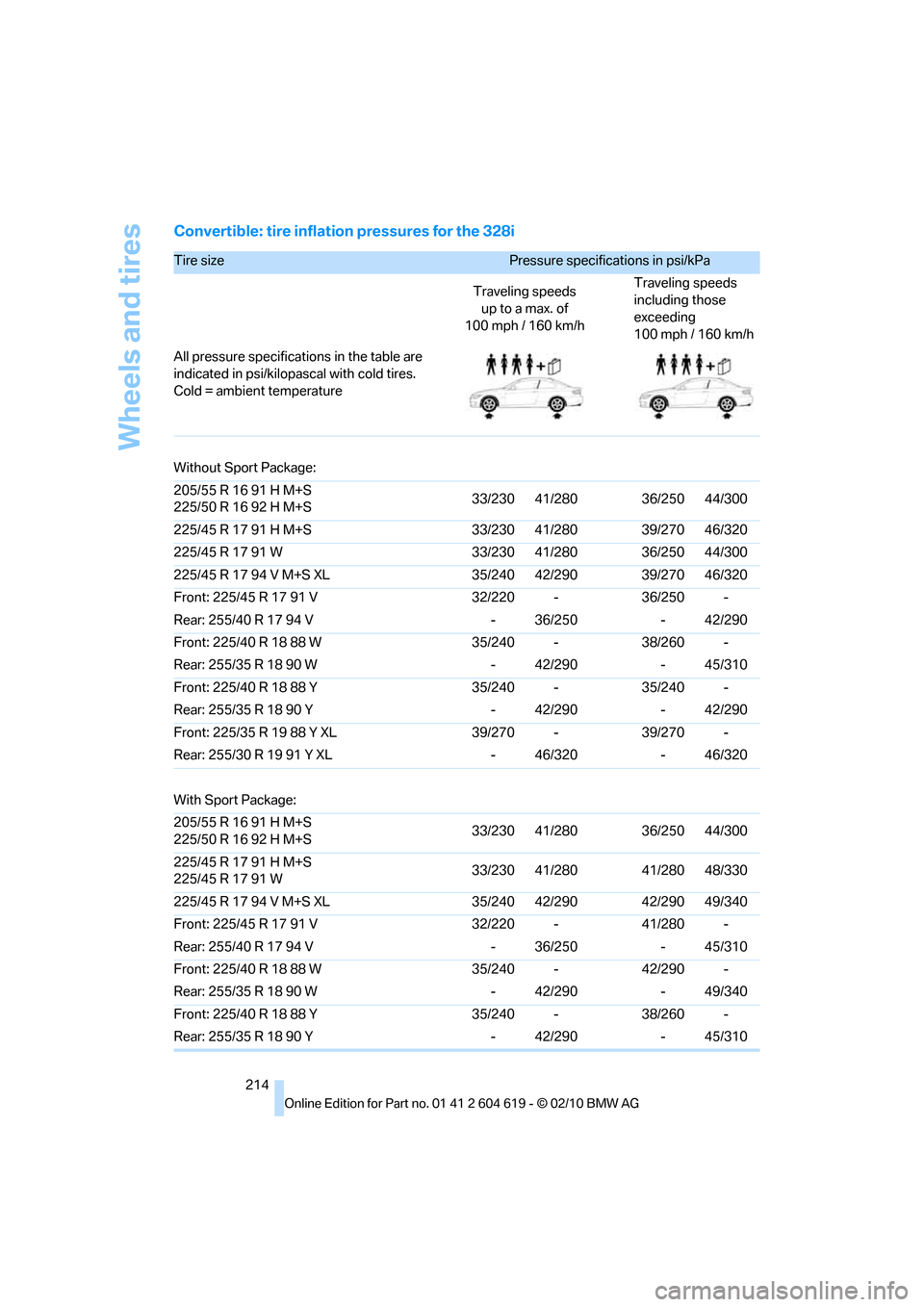
Wheels and tires
214
Convertible: tire inflation pressures for the 328i
Tire size Pressure specifications in psi/kPa
Traveling speeds
up to a max. of
100 mph / 160 km/hTraveling speeds
including those
exceeding
100 mph / 160 km/h
All pressure specifications in the table are
indicated in psi/kilopascal with cold tires.
Cold = ambient temperature
Without Sport Package:
205/55 R 16 91 H M+S
225/50 R 16 92 H M+S33/230 41/280 36/250 44/300
225/45 R 17 91 H M+S 33/230 41/280 39/270 46/320
225/45 R 17 91 W 33/230 41/280 36/250 44/300
225/45 R 17 94 V M+S XL 35/240 42/290 39/270 46/320
Front: 225/45 R 17 91 V 32/220 - 36/250 -
Rear: 255/40 R 17 94 V - 36/250 - 42/290
Front: 225/40 R 18 88 W 35/240 - 38/260 -
Rear: 255/35 R 18 90 W - 42/290 - 45/310
Front: 225/40 R 18 88 Y 35/240 - 35/240 -
Rear: 255/35 R 18 90 Y - 42/290 - 42/290
Front: 225/35 R 19 88 Y XL 39/270 - 39/270 -
Rear: 255/30 R 19 91 Y XL - 46/320 - 46/320
With Sport Package:
205/55 R 16 91 H M+S
225/50 R 16 92 H M+S33/230 41/280 36/250 44/300
225/45 R 17 91 H M+S
225/45 R 17 91 W33/230 41/280 41/280 48/330
225/45 R 17 94 V M+S XL 35/240 42/290 42/290 49/340
Front: 225/45 R 17 91 V 32/220 - 41/280 -
Rear: 255/40 R 17 94 V - 36/250 - 45/310
Front: 225/40 R 18 88 W 35/240 - 42/290 -
Rear: 255/35 R 18 90 W - 42/290 - 49/340
Front: 225/40 R 18 88 Y 35/240 - 38/260 -
Rear: 255/35 R 18 90 Y - 42/290 - 45/310
Page 218 of 278
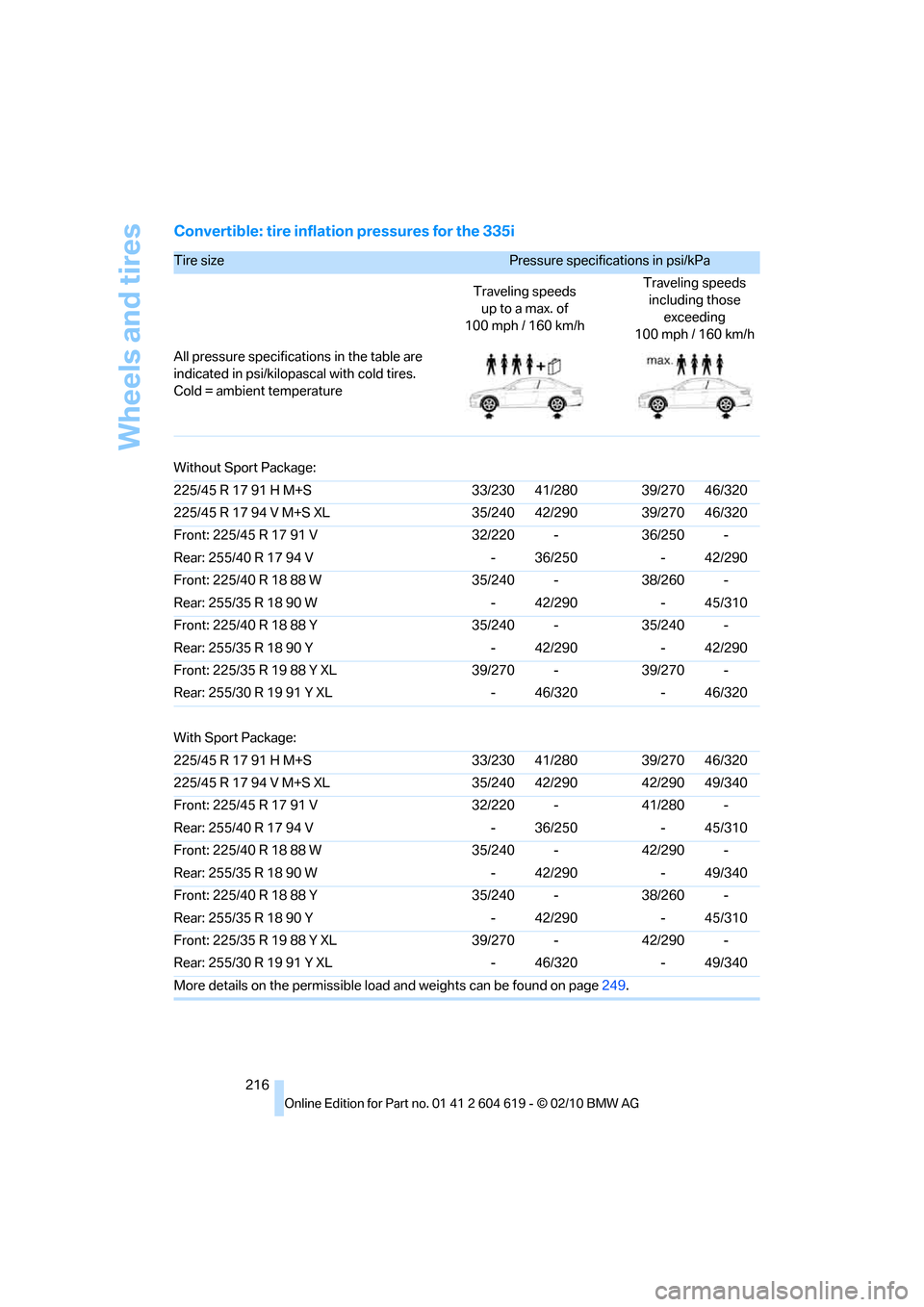
Wheels and tires
216
Convertible: tire inflation pressures for the 335i
Tire size Pressure specifications in psi/kPa
Traveling speeds
up to a max. of
100 mph / 160 km/hTraveling speeds
including those
exceeding
100 mph / 160 km/h
All pressure specifications in the table are
indicated in psi/kilopascal with cold tires.
Cold = ambient temperature
Without Sport Package:
225/45 R 17 91 H M+S 33/230 41/280 39/270 46/320
225/45 R 17 94 V M+S XL 35/240 42/290 39/270 46/320
Front: 225/45 R 17 91 V 32/220 - 36/250 -
Rear: 255/40 R 17 94 V - 36/250 - 42/290
Front: 225/40 R 18 88 W 35/240 - 38/260 -
Rear: 255/35 R 18 90 W - 42/290 - 45/310
Front: 225/40 R 18 88 Y 35/240 - 35/240 -
Rear: 255/35 R 18 90 Y - 42/290 - 42/290
Front: 225/35 R 19 88 Y XL 39/270 - 39/270 -
Rear: 255/30 R 19 91 Y XL - 46/320 - 46/320
With Sport Package:
225/45 R 17 91 H M+S 33/230 41/280 39/270 46/320
225/45 R 17 94 V M+S XL 35/240 42/290 42/290 49/340
Front: 225/45 R 17 91 V 32/220 - 41/280 -
Rear: 255/40 R 17 94 V - 36/250 - 45/310
Front: 225/40 R 18 88 W 35/240 - 42/290 -
Rear: 255/35 R 18 90 W - 42/290 - 49/340
Front: 225/40 R 18 88 Y 35/240 - 38/260 -
Rear: 255/35 R 18 90 Y - 42/290 - 45/310
Front: 225/35 R 19 88 Y XL 39/270 - 42/290 -
Rear: 255/30 R 19 91 Y XL - 46/320 - 49/340
More details on the permissible load and weights can be found on page249.
Page 219 of 278
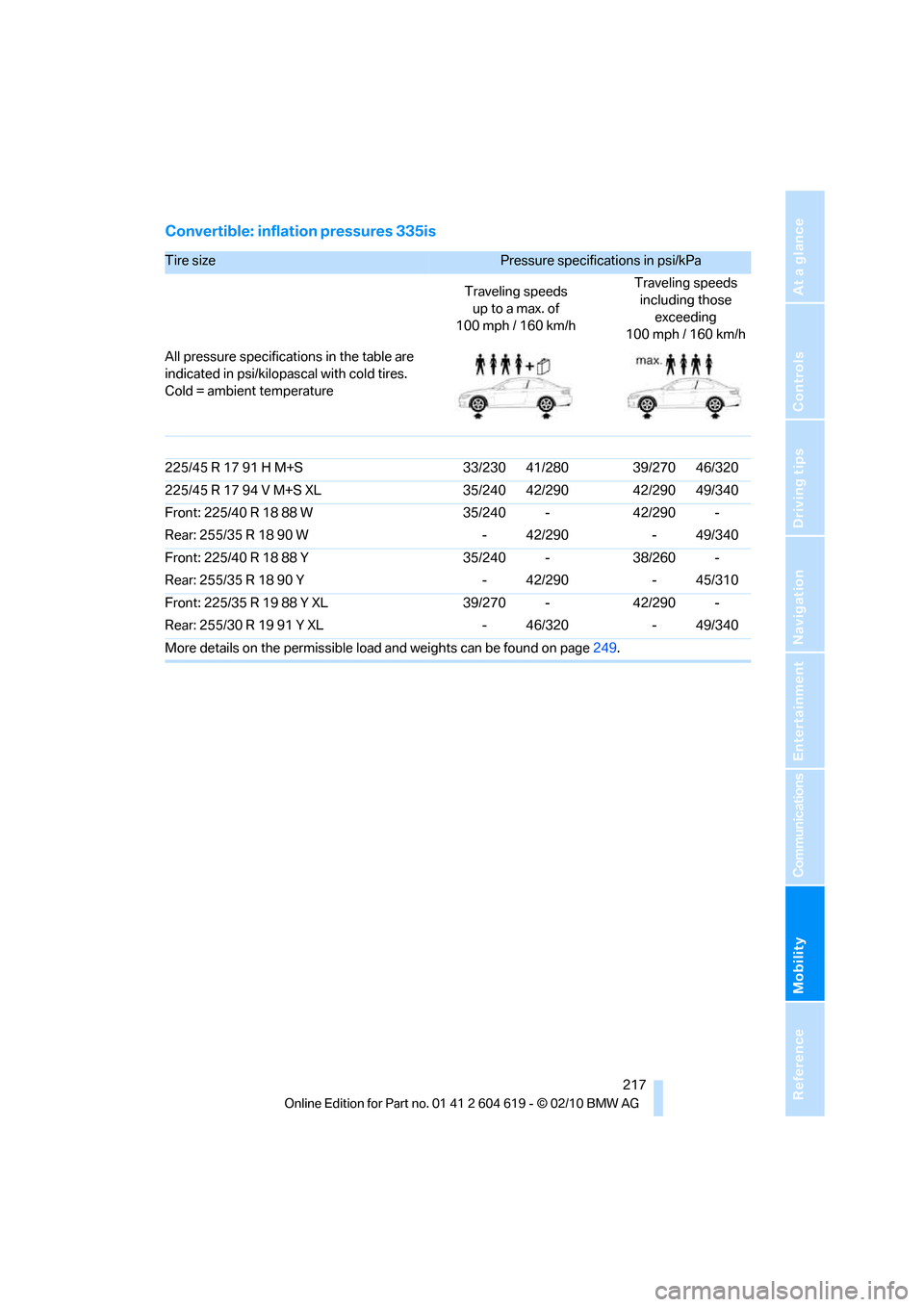
Mobility
217Reference
At a glance
Controls
Driving tips
Communications
Navigation
Entertainment
Convertible: inflation pressures 335is
Tire size Pressure specifications in psi/kPa
Traveling speeds
up to a max. of
100 mph / 160 km/hTraveling speeds
including those
exceeding
100 mph / 160 km/h
All pressure specifications in the table are
indicated in psi/kilopascal with cold tires.
Cold = ambient temperature
225/45 R 17 91 H M+S 33/230 41/280 39/270 46/320
225/45 R 17 94 V M+S XL 35/240 42/290 42/290 49/340
Front: 225/40 R 18 88 W 35/240 - 42/290 -
Rear: 255/35 R 18 90 W - 42/290 - 49/340
Front: 225/40 R 18 88 Y 35/240 - 38/260 -
Rear: 255/35 R 18 90 Y - 42/290 - 45/310
Front: 225/35 R 19 88 Y XL 39/270 - 42/290 -
Rear: 255/30 R 19 91 Y XL - 46/320 - 49/340
More details on the permissible load and weights can be found on page249.
Page 221 of 278
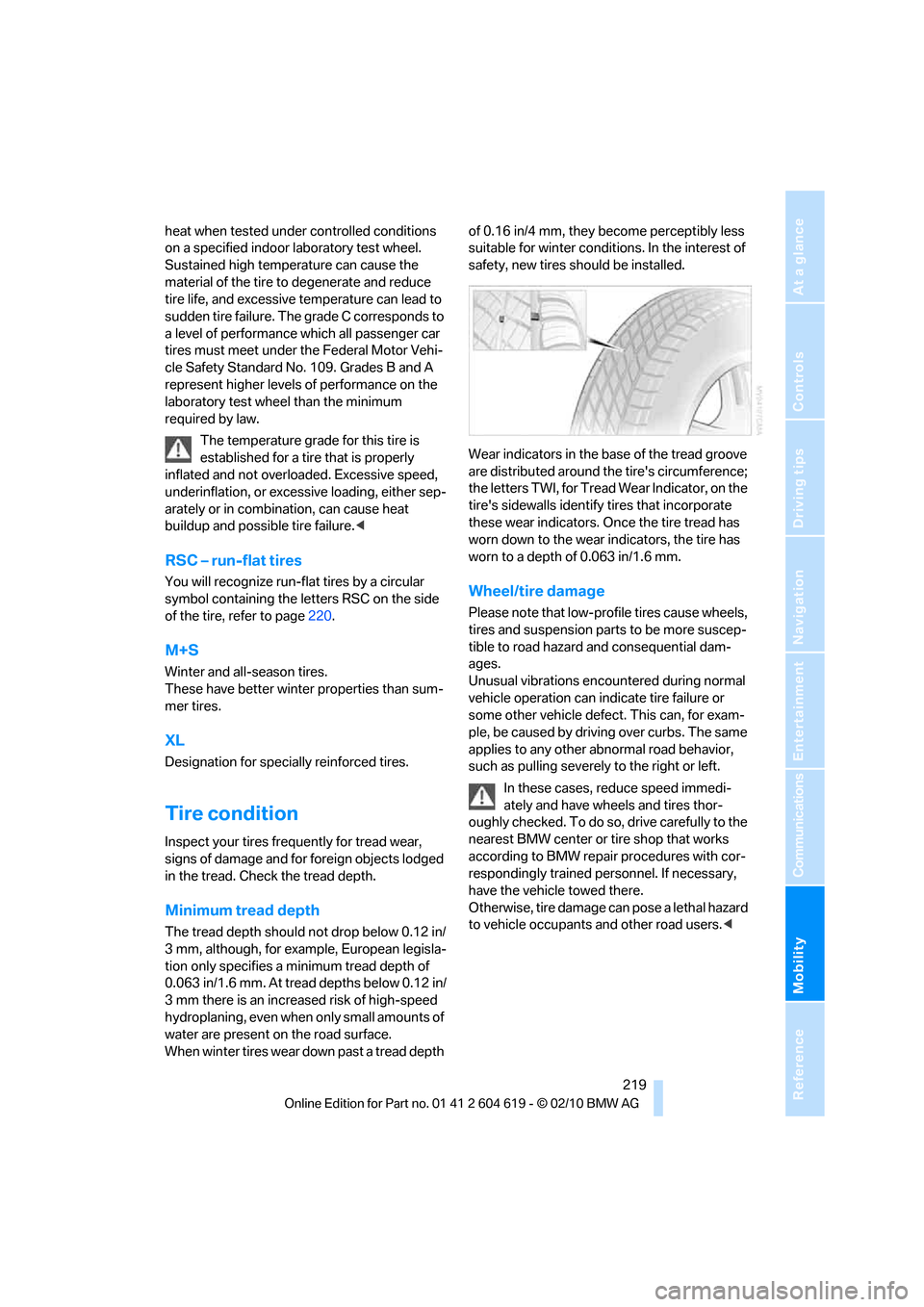
Mobility
219Reference
At a glance
Controls
Driving tips
Communications
Navigation
Entertainment
heat when tested under controlled conditions
on a specified indoor laboratory test wheel.
Sustained high temperature can cause the
material of the tire to degenerate and reduce
tire life, and excessive temperature can lead to
sudden tire failure. The grade C corresponds to
a level of performance which all passenger car
tires must meet under the Federal Motor Vehi-
cle Safety Standard No. 109. Grades B and A
represent higher levels of performance on the
laboratory test wheel than the minimum
required by law.
The temperature grade for this tire is
established for a tire that is properly
inflated and not overloaded. Excessive speed,
underinflation, or excessive loading, either sep-
arately or in combination, can cause heat
buildup and possible tire failure.<
RSC – run-flat tires
You will recognize run-flat tires by a circular
symbol containing the letters RSC on the side
of the tire, refer to page220.
M+S
Winter and all-season tires.
These have better winter properties than sum-
mer tires.
XL
Designation for specially reinforced tires.
Tire condition
Inspect your tires frequently for tread wear,
signs of damage and for foreign objects lodged
in the tread. Check the tread depth.
Minimum tread depth
The tread depth should not drop below 0.12 in/
3 mm, although, for example, European legisla-
tion only specifies a minimum tread depth of
0.063 in/1.6 mm. At tread depths below 0.12 in/
3 mm there is an increased risk of high-speed
hydroplaning, even when only small amounts of
water are present on the road surface.
When winter tires wear down past a tread depth of 0.16 in/4 mm, they become perceptibly less
suitable for winter conditions. In the interest of
safety, new tires should be installed.
Wear indicators in the base of the tread groove
are distributed around the tire's circumference;
the letters TWI, for Tread Wear Indicator, on the
tire's sidewalls identify tires that incorporate
these wear indicators. Once the tire tread has
worn down to the wear indicators, the tire has
worn to a depth of 0.063 in/1.6 mm.
Wheel/tire damage
Please note that low-profile tires cause wheels,
tires and suspension parts to be more suscep-
tible to road hazard and consequential dam-
ages.
Unusual vibrations encountered during normal
vehicle operation can indicate tire failure or
some other vehicle defect. This can, for exam-
ple, be caused by driving over curbs. The same
applies to any other abnormal road behavior,
such as pulling severely to the right or left.
In these cases, reduce speed immedi-
ately and have wheels and tires thor-
oughly checked. To do so, drive carefully to the
nearest BMW center or tire shop that works
according to BMW repair procedures with cor-
respondingly trained personnel. If necessary,
have the vehicle towed there.
Otherwise, tire damage can pose a lethal hazard
to vehicle occupants and other road users.<
Page 222 of 278
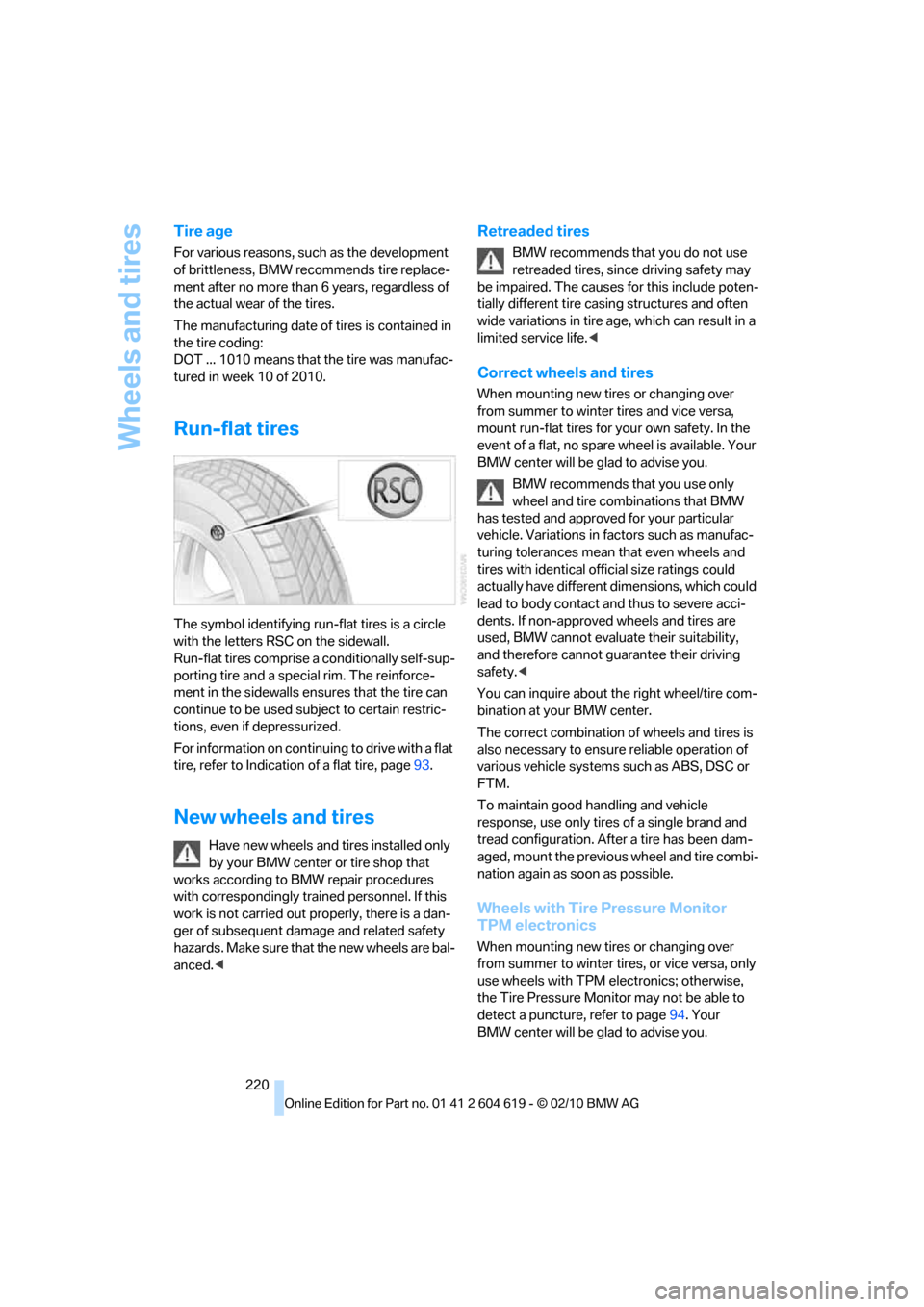
Wheels and tires
220
Tire age
For various reasons, such as the development
of brittleness, BMW recommends tire replace-
ment after no more than 6 years, regardless of
the actual wear of the tires.
The manufacturing date of tires is contained in
the tire coding:
DOT ... 1010 means that the tire was manufac-
tured in week 10 of 2010.
Run-flat tires
The symbol identifying run-flat tires is a circle
with the letters RSC on the sidewall.
Run-flat tires comprise a conditionally self-sup-
porting tire and a special rim. The reinforce-
ment in the sidewalls ensures that the tire can
continue to be used subject to certain restric-
tions, even if depressurized.
For information on continuing to drive with a flat
tire, refer to Indication of a flat tire, page93.
New wheels and tires
Have new wheels and tires installed only
by your BMW center or tire shop that
works according to BMW repair procedures
with correspondingly trained personnel. If this
work is not carried out properly, there is a dan-
ger of subsequent damage and related safety
hazards. Make sure that the new wheels are bal-
anced.<
Retreaded tires
BMW recommends that you do not use
retreaded tires, since driving safety may
be impaired. The causes for this include poten-
tially different tire casing structures and often
wide variations in tire age, which can result in a
limited service life.<
Correct wheels and tires
When mounting new tires or changing over
from summer to winter tires and vice versa,
mount run-flat tires for your own safety. In the
event of a flat, no spare wheel is available. Your
BMW center will be glad to advise you.
BMW recommends that you use only
wheel and tire combinations that BMW
has tested and approved for your particular
vehicle. Variations in factors such as manufac-
turing tolerances mean that even wheels and
tires with identical official size ratings could
actually have different dimensions, which could
lead to body contact and thus to severe acci-
dents. If non-approved wheels and tires are
used, BMW cannot evaluate their suitability,
and therefore cannot guarantee their driving
safety.<
You can inquire about the right wheel/tire com-
bination at your BMW center.
The correct combination of wheels and tires is
also necessary to ensure reliable operation of
various vehicle systems such as ABS, DSC or
FTM.
To maintain good handling and vehicle
response, use only tires of a single brand and
tread configuration. After a tire has been dam-
aged, mount the previous wheel and tire combi-
nation again as soon as possible.
Wheels with Tire Pressure Monitor
TPM electronics
When mounting new tires or changing over
from summer to winter tires, or vice versa, only
use wheels with TPM electronics; otherwise,
the Tire Pressure Monitor may not be able to
detect a puncture, refer to page94. Your
BMW center will be glad to advise you.
Page 223 of 278
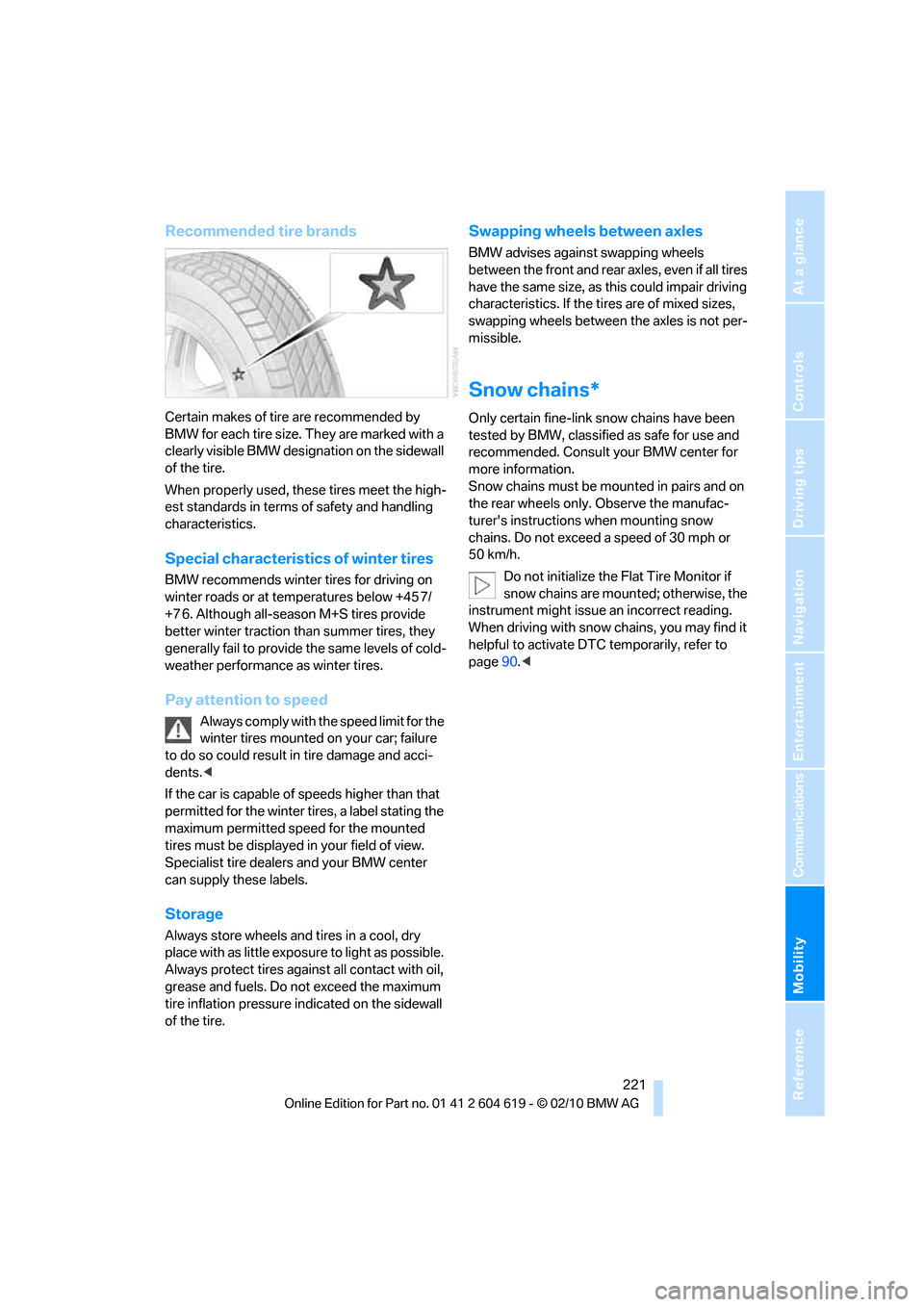
Mobility
221Reference
At a glance
Controls
Driving tips
Communications
Navigation
Entertainment
Recommended tire brands
Certain makes of tire are recommended by
BMW for each tire size. They are marked with a
clearly visible BMW designation on the sidewall
of the tire.
When properly used, these tires meet the high-
est standards in terms of safety and handling
characteristics.
Special characteristics of winter tires
BMW recommends winter tires for driving on
winter roads or at temperatures below +45 7/
+7 6. Although all-season M+S tires provide
better winter traction than summer tires, they
generally fail to provide the same levels of cold-
weather performance as winter tires.
Pay attention to speed
Always comply with the speed limit for the
winter tires mounted on your car; failure
to do so could result in tire damage and acci-
dents.<
If the car is capable of speeds higher than that
permitted for the winter tires, a label stating the
maximum permitted speed for the mounted
tires must be displayed in your field of view.
Specialist tire dealers and your BMW center
can supply these labels.
Storage
Always store wheels and tires in a cool, dry
place with as little exposure to light as possible.
Always protect tires against all contact with oil,
grease and fuels. Do not exceed the maximum
tire inflation pressure indicated on the sidewall
of the tire.
Swapping wheels between axles
BMW advises against swapping wheels
between the front and rear axles, even if all tires
have the same size, as this could impair driving
characteristics. If the tires are of mixed sizes,
swapping wheels between the axles is not per-
missible.
Snow chains*
Only certain fine-link snow chains have been
tested by BMW, classified as safe for use and
recommended. Consult your BMW center for
more information.
Snow chains must be mounted in pairs and on
the rear wheels only. Observe the manufac-
turer's instructions when mounting snow
chains. Do not exceed a speed of 30 mph or
50 km/h.
Do not initialize the Flat Tire Monitor if
snow chains are mounted; otherwise, the
instrument might issue an incorrect reading.
When driving with snow chains, you may find it
helpful to activate DTC temporarily, refer to
page90.<
Page 238 of 278
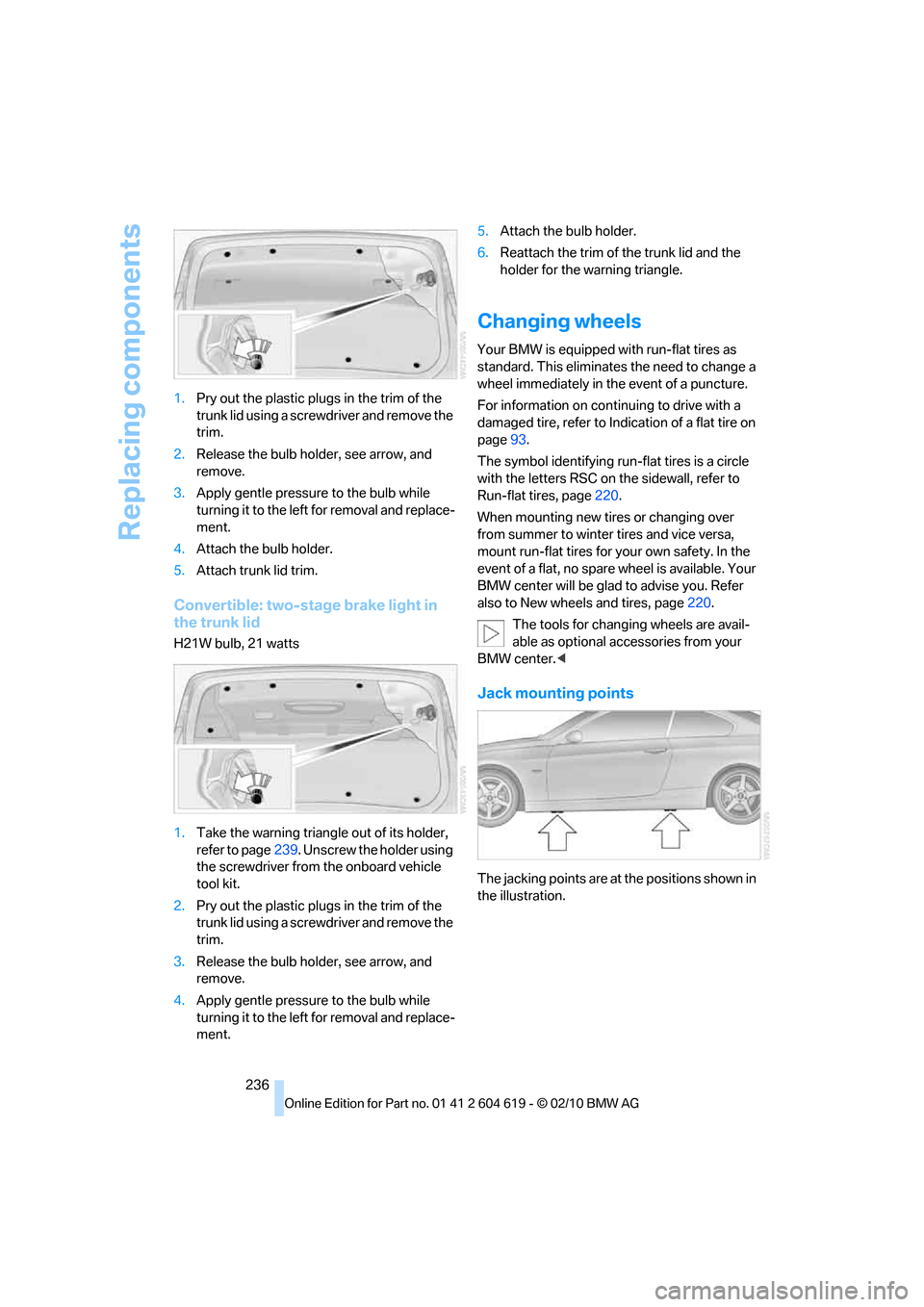
Replacing components
236 1.Pry out the plastic plugs in the trim of the
trunk lid using a screwdriver and remove the
trim.
2.Release the bulb holder, see arrow, and
remove.
3.Apply gentle pressure to the bulb while
turning it to the left for removal and replace-
ment.
4.Attach the bulb holder.
5.Attach trunk lid trim.
Convertible: two-stage brake light in
the trunk lid
H21W bulb, 21 watts
1.Take the warning triangle out of its holder,
refer to page239. Unscrew the holder using
the screwdriver from the onboard vehicle
tool kit.
2.Pry out the plastic plugs in the trim of the
trunk lid using a screwdriver and remove the
trim.
3.Release the bulb holder, see arrow, and
remove.
4.Apply gentle pressure to the bulb while
turning it to the left for removal and replace-
ment.5.Attach the bulb holder.
6.Reattach the trim of the trunk lid and the
holder for the warning triangle.
Changing wheels
Your BMW is equipped with run-flat tires as
standard. This eliminates the need to change a
wheel immediately in the event of a puncture.
For information on continuing to drive with a
damaged tire, refer to Indication of a flat tire on
page93.
The symbol identifying run-flat tires is a circle
with the letters RSC on the sidewall, refer to
Run-flat tires, page220.
When mounting new tires or changing over
from summer to winter tires and vice versa,
mount run-flat tires for your own safety. In the
event of a flat, no spare wheel is available. Your
BMW center will be glad to advise you. Refer
also to New wheels and tires, page220.
The tools for changing wheels are avail-
able as optional accessories from your
BMW center.<
Jack mounting points
The jacking points are at the positions shown in
the illustration.
Page 260 of 278
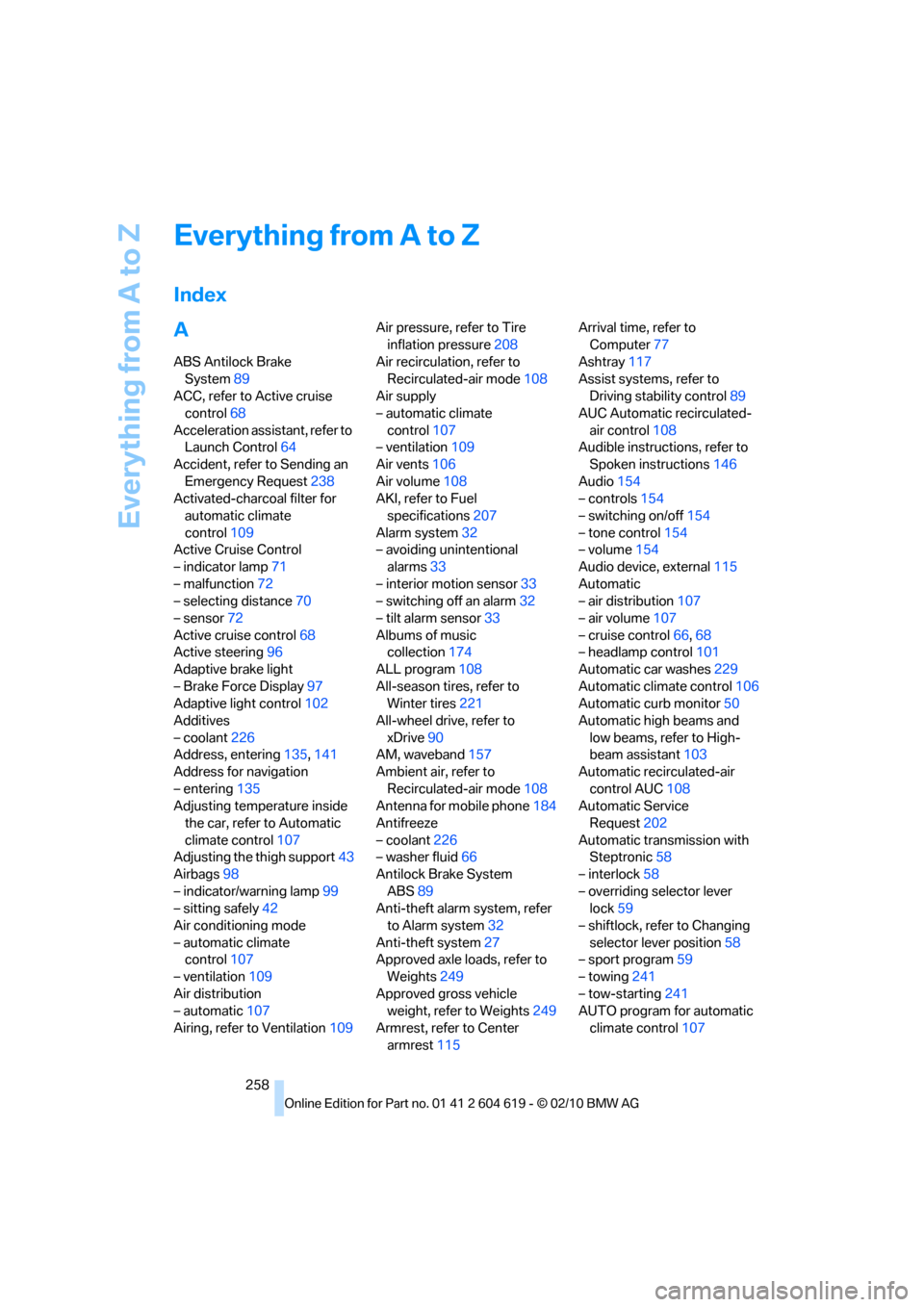
Everything from A to Z
258
Everything from A to Z
Index
A
ABS Antilock Brake
System89
ACC, refer to Active cruise
control68
Acceleration assistant, refer to
Launch Control64
Accident, refer to Sending an
Emergency Request238
Activated-charcoal filter for
automatic climate
control109
Active Cruise Control
– indicator lamp71
– malfunction72
– selecting distance70
– sensor72
Active cruise control68
Active steering96
Adaptive brake light
– Brake Force Display97
Adaptive light control102
Additives
– coolant226
Address, entering135,141
Address for navigation
– entering135
Adjusting temperature inside
the car, refer to Automatic
climate control107
Adjusting the thigh support43
Airbags98
– indicator/warning lamp99
– sitting safely42
Air conditioning mode
– automatic climate
control107
– ventilation109
Air distribution
– automatic107
Airing, refer to Ventilation109Air pressure, refer to Tire
inflation pressure208
Air recirculation, refer to
Recirculated-air mode108
Air supply
– automatic climate
control107
– ventilation109
Air vents106
Air volume108
AKI, refer to Fuel
specifications207
Alarm system32
– avoiding unintentional
alarms33
– interior motion sensor33
– switching off an alarm32
– tilt alarm sensor33
Albums of music
collection174
ALL program108
All-season tires, refer to
Winter tires221
All-wheel drive, refer to
xDrive90
AM, waveband157
Ambient air, refer to
Recirculated-air mode108
Antenna for mobile phone184
Antifreeze
– coolant226
– washer fluid66
Antilock Brake System
ABS89
Anti-theft alarm system, refer
to Alarm system32
Anti-theft system27
Approved axle loads, refer to
Weights249
Approved gross vehicle
weight, refer to Weights249
Armrest, refer to Center
armrest115Arrival time, refer to
Computer77
Ashtray117
Assist systems, refer to
Driving stability control89
AUC Automatic recirculated-
air control108
Audible instructions, refer to
Spoken instructions146
Audio154
– controls154
– switching on/off154
– tone control154
– volume154
Audio device, external115
Automatic
– air distribution107
– air volume107
– cruise control66,68
– headlamp control101
Automatic car washes229
Automatic climate control106
Automatic curb monitor50
Automatic high beams and
low beams, refer to High-
beam assistant103
Automatic recirculated-air
control AUC108
Automatic Service
Request202
Automatic transmission with
Steptronic58
– interlock58
– overriding selector lever
lock59
– shiftlock, refer to Changing
selector lever position58
– sport program59
– towing
241
– tow-starting241
AUTO program for automatic
climate control107